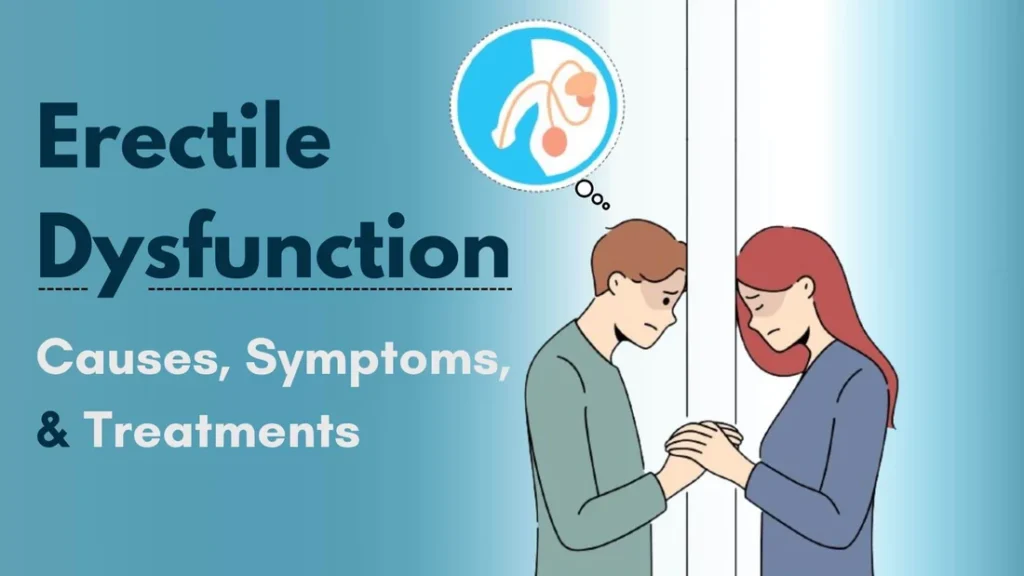Erectile Dysfunction (ED) is a common but often misunderstood condition that affects millions of men worldwide. While occasional difficulty with erections is normal, ED refers to the persistent inability to achieve or maintain an erection firm enough for sexual intercourse. It can have physical, psychological, or lifestyle-related causes—and it’s treatable in most cases.
This guide breaks down what ED is, its causes, symptoms, and the wide range of treatment options available to help men regain sexual function and confidence.
🧠 What Is Erectile Dysfunction?
Erectile dysfunction is classified as a sexual dysfunction and is clinically defined by:
- Inability to get an erection
- Inability to maintain an erection
- Reduced sexual desire (sometimes associated)
It is estimated that up to 30 million men in the U.S. alone suffer from ED, and prevalence increases with age—but it’s not an inevitable part of aging.
🛑 Is ED the Same as Low Libido?
No. ED is a mechanical or physiological issue related to the penis, while low libido refers to decreased sexual desire. However, the two can be related. For example, psychological causes like depression may contribute to both.
🔍 Common Causes of Erectile Dysfunction
ED can result from a complex interaction between physical, emotional, and psychological factors. The most common causes include:
🔬 Physical Causes:
- Cardiovascular disease: Poor blood flow due to clogged arteries
- Diabetes: Damages nerves and blood vessels
- High blood pressure: Reduces blood flow to the penis
- Hormonal imbalances: Low testosterone or thyroid issues
- Neurological conditions: Parkinson’s disease, multiple sclerosis
- Peyronie’s disease: Scar tissue that causes penile curvature
- Obesity or metabolic syndrome
💊 Medication-Induced ED:
Some drugs can interfere with sexual function, including:
- Antidepressants (SSRIs)
- Blood pressure medications
- Anti-anxiety drugs
- Antihistamines
- Chemotherapy drugs
🧠 Psychological Causes:
- Stress or anxiety (including performance anxiety)
- Depression
- Relationship issues
- Trauma or past abuse
🚬 Lifestyle Contributors:
- Smoking
- Excessive alcohol consumption
- Lack of exercise
- Poor diet
- Sleep disorders
⚠️ Symptoms of Erectile Dysfunction
- Difficulty getting an erection
- Difficulty maintaining an erection during intercourse
- Reduced interest in sex
- Emotional distress or embarrassment
- Strained relationships or intimacy issues
If these symptoms persist for more than 3 months, it’s time to seek medical advice.
🧪 How Is ED Diagnosed?
A healthcare provider will conduct:
- Medical history review
- Physical examination
- Blood tests (to check for diabetes, cholesterol, testosterone)
- Urine tests
- Ultrasound (to check blood flow to the penis)
- Psychological screening (if mental health is a suspected factor)
💊 Treatment Options for Erectile Dysfunction
1. Oral Medications (PDE5 Inhibitors)
These are first-line treatments and include:
- Sildenafil (Viagra)
- Tadalafil (Cialis)
- Vardenafil (Levitra, Staxyn)
- Avanafil (Stendra)
They work by improving blood flow to the penis, usually taken before sexual activity.
Note: These require sexual stimulation to be effective and may cause side effects like headaches or nasal congestion.
2. Hormone Therapy
- Testosterone Replacement Therapy (TRT) is prescribed if blood tests show low testosterone.
- Can be administered via gel, injection, patches, or pellets.
⚠️ Not suitable for all men, especially those with prostate cancer risk.
3. Lifestyle Modifications
- Quit smoking
- Limit alcohol
- Exercise regularly (improves circulation and testosterone)
- Lose excess weight
- Manage stress and mental health
Even small changes can significantly improve sexual health.
4. Psychotherapy or Counseling
Effective for men whose ED is linked to:
- Performance anxiety
- Relationship problems
- Depression or PTSD
Therapy can be done solo or with a partner to rebuild intimacy and confidence.
5. Vacuum Erection Devices (Penis Pumps)
These non-invasive devices draw blood into the penis via suction, followed by placement of a constriction ring to maintain the erection.
- Good for men who can’t take pills
- Results may be less spontaneous or natural
6. Penile Injections
Medication (such as alprostadil) is injected directly into the side of the penis to create an erection.
- Fast-acting (within minutes)
- Highly effective, but some men are uncomfortable with the method
7. Intraurethral Suppositories
Small pellets of medication (also alprostadil) inserted into the urethra with an applicator. Less invasive than injections but less effective for some men.
8. Surgical Options: Penile Implants
For men who haven’t responded to other treatments:
- Inflatable implants (hydraulic pumps)
- Semi-rigid implants (bendable rods)
Highly effective with high satisfaction rates but involve irreversible surgery.
9. Shockwave Therapy & PRP (Emerging Treatments)
- Low-Intensity Extracorporeal Shockwave Therapy (LI-ESWT): Improves blood vessel health in the penis.
- Platelet-Rich Plasma (PRP) Injections: “P-Shot” may help stimulate tissue repair.
These are still under clinical evaluation but show promise for some patients.
🌍 Erectile Dysfunction and Medical Tourism
Men increasingly travel abroad for ED treatments due to:
- Lower costs
- Access to innovative technologies
- Privacy
- Combined wellness retreats or recovery spas
Top destinations include Turkey, Thailand, Mexico, UAE, and South Korea, offering advanced ED solutions in safe, accredited clinics.
📌 When to See a Doctor
You should consult a doctor if:
- ED occurs regularly and is interfering with your relationship or quality of life
- You experience other symptoms like reduced libido, pain, or low energy
- You suspect medications or chronic conditions may be affecting your performance
✅ Conclusion: ED Is Treatable—Don’t Suffer in Silence
Erectile dysfunction is common and nothing to be ashamed of. Whether the cause is physical, emotional, or both, effective treatments are available to restore your sexual health and confidence.
The first step is starting the conversation—with a doctor, a partner, or a specialist. With the right support and treatment plan, ED can be managed or even reversed.




